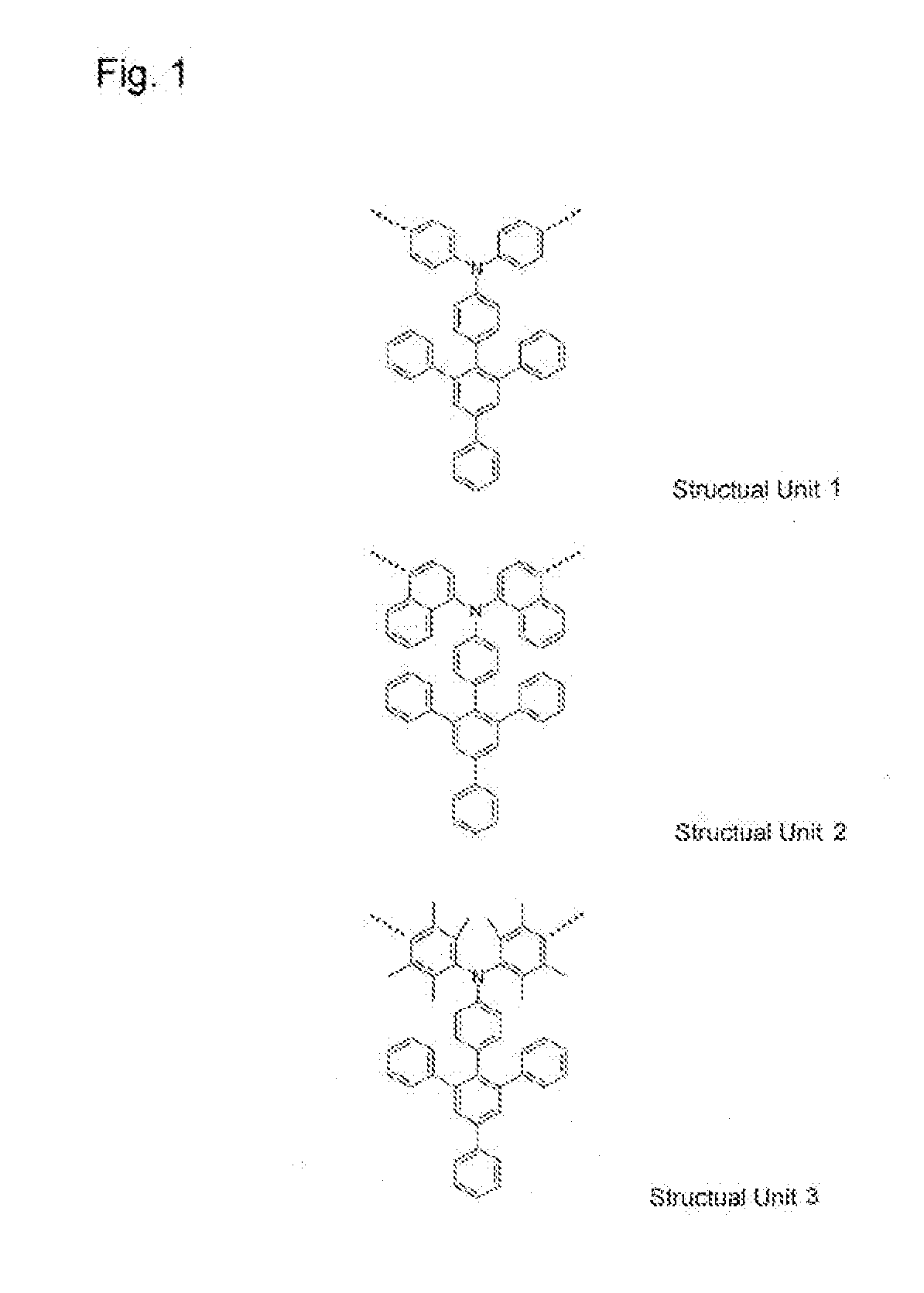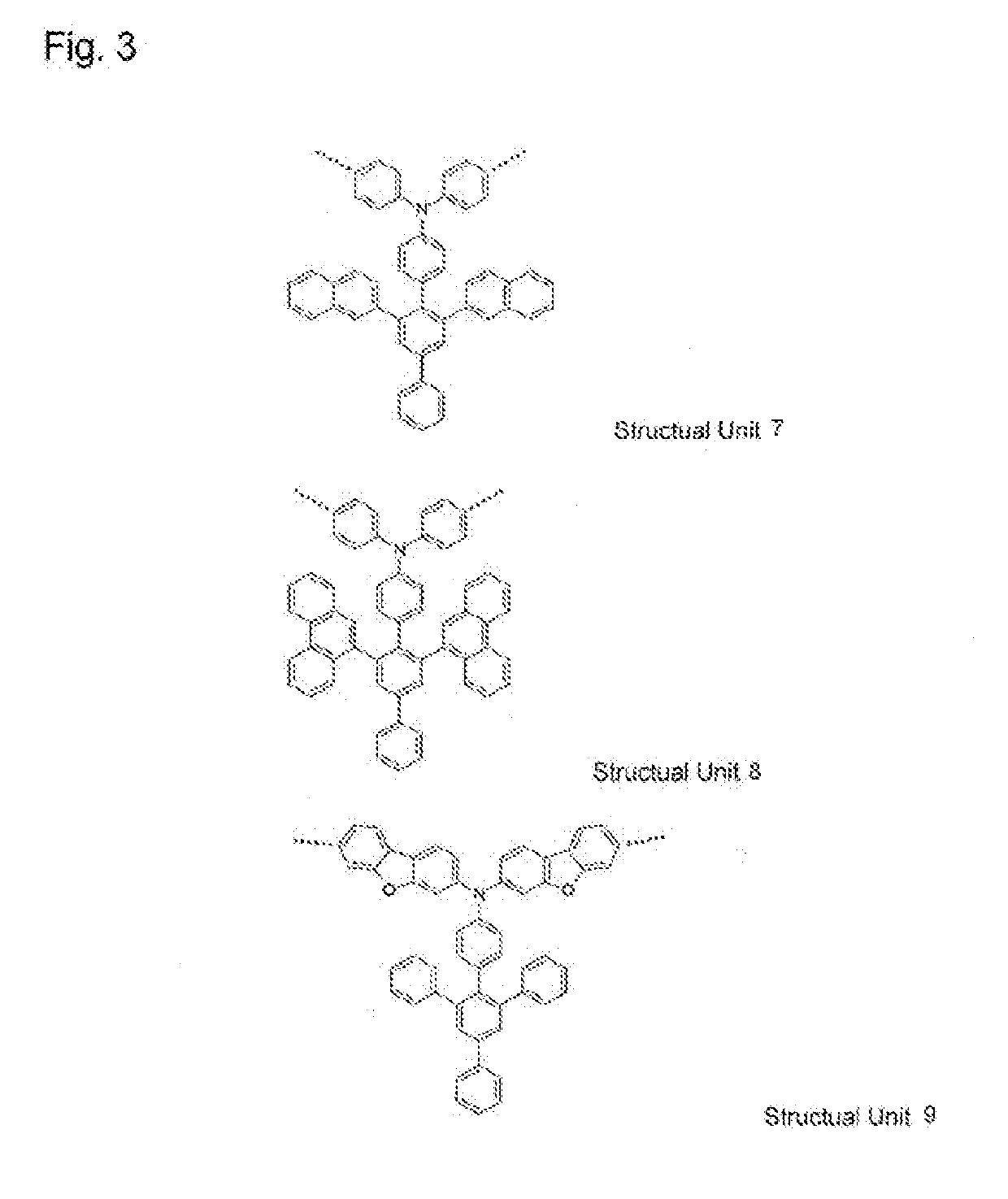High molecular weight compound containing substituted triarylamine structural unit
- Summary
- Abstract
- Description
- Claims
- Application Information
AI Technical Summary
Benefits of technology
Problems solved by technology
Method used
Image
Examples
example 1
Synthesis of High Molecular Weight Compound A
[0228]The following components were placed in a reaction vessel whose internal air was replaced with nitrogen, and nitrogen gas was passed through the reaction vessel for 30 minutes:
[0229]15.0 g of intermediate 1;
[0230]2.0 g of intermediate 3;
[0231]13.2 g of intermediate 5;
[0232]20.8 g of tripotassium phosphate;
[0233]60 ml of toluene;
[0234]33 ml of water; and
[0235]180 ml of 1,4-dioxane.
[0236]Then, 5.0 mg of palladium(II) acetate and 40.5 mg of tri-o-tolylphosphine were added, and the mixture was heated and stirred at 80° C. for 7 hours.
[0237]Then, 0.27 g of intermediate 1 was added and the mixture was stirred for 1 hour, and then 0.73 g of bromobenzene was added and the mixture was stirred for 1 hour.
[0238]After the mixture was cooled down to room temperature, 500 ml of toluene and 200 ml of 5 wt % aqueous solution of N,N-sodium diethyldithiocarbamate were added, and the mixture was stirred under reflux for 2 hours.
[0239]Then, the mixture...
example 2
[0247]A deposition film having a thickness of 100 nm was formed on an ITO substrate using the high molecular weight compound A synthesized in Example 1, and work function was measured using an ionization potential measurement apparatus (Model PYS-202 available from Sumitomo Heavy Industries, Ltd.). The result was as follows.
Work functionHigh molecular weight compound A (polymer)5.63 eV
[0248]The high molecular weight compound A according to the present invention exhibited an energy level higher than 5.4 eV that is the work function of ordinary hole transport materials such as NPD and TPD, from which it can be seen that the high molecular weight compound A has good hole transport capability.
example 3
Production and Evaluation of Organic EL Element
[0249]An organic EL element having a layer structure shown in FIG. 22 was produced in the following manner.
[0250]A glass substrate 1 on which an ITO film (transparent positive electrode 2) having a thickness of 50 nm was formed was washed with an organic solvent, and then UV / ozone treatment was performed to wash the surface of the ITO film.
[0251]A compound having the following structural formula (AQ-1200 available from Solvay) was applied using a spin coating method so as to cover the transparent positive electrode 2 (ITO film) formed on the glass substrate 1, and a 55 nm thick film was thereby formed. The film was dried on a hot plate at 170° C. for 10 minutes, and a hole injection layer 3 was thereby formed.
[0252]A coating solution was prepared by dissolving the high molecular weight compound A obtained in Example 1 in anisole at a concentration of 0.8 wt %.
[0253]The substrate on which the hole injection layer 3 was formed in the mann...
PUM
| Property | Measurement | Unit |
|---|---|---|
| Fraction | aaaaa | aaaaa |
| Fraction | aaaaa | aaaaa |
| Fraction | aaaaa | aaaaa |
Abstract
Description
Claims
Application Information
 Login to View More
Login to View More - R&D
- Intellectual Property
- Life Sciences
- Materials
- Tech Scout
- Unparalleled Data Quality
- Higher Quality Content
- 60% Fewer Hallucinations
Browse by: Latest US Patents, China's latest patents, Technical Efficacy Thesaurus, Application Domain, Technology Topic, Popular Technical Reports.
© 2025 PatSnap. All rights reserved.Legal|Privacy policy|Modern Slavery Act Transparency Statement|Sitemap|About US| Contact US: help@patsnap.com



